Menus
- Roadster Sport-Heritage Fasters Sons
- Strength of character
- Discovery
- In the saddle
- In the city
- Motorway and expressways
- Departmental
- Part-cycle
- Braking
- Comfort / Duo
- Consumption
- Conclusion
Roadster Sport-Heritage Fasters Sons
Following on from the XSR 700, Yamaha today unveils its new Sport-Heritage XSR 900 roadster in dynamic fashion. Based on the sulphurous MT09, the novelty optimizes its genetics and is adorned with an aesthetic reflecting, in vintage format, its strength mechanical.
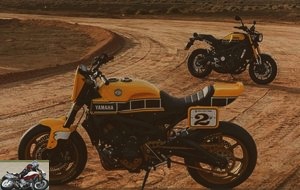
Strength of character
Drawing on its rich history, Yamaha adds to its classic motorcycles the stylish and retro transcription of some of its current machines. Since 2010, through the concepts of his Yart Build workshop and through collaborations with well-known signatures, such as Roland Sands, his modern roadsters have taken on a studied nostalgia. Thus, the Sport Heritage range, developed under the "Faster Sons" conceptual umbrella already includes many models, divided into two branches defining a variable modernity. More "Heritage", with a classic design and air-cooled engine, we find the SR400, XV950 Bolt and XJR1300.
More "Sport", these latest models are based on the latest technological standard. The sparkling MT07 thus became XSR 700, asserting itself as a descendant of the XS 650 of 1970.

After the enthronement of its sulphurous MT09, the tuning fork brand presents a new more nostalgic version of its roadster, a reminder of the XS750 and 850 three cylinder from 1976. If the very structure of the machine renews that of the MT09, the trim is original, just like the design. Because, as the product manager Shun Miyazawa insists, the XSR 900 is developed by Yamaha, via its external design office GK dynamic. For 60 years, this structure has been developing the style of tuning fork machines. Here is the XSR 900, eldest daughter of this techno-retro range, effectively mixing genres, for a test on the island of Fuerteventura (Spain).
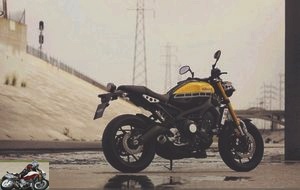
Discovery
With its MT09, Yamaha had surprised and delighted fans of character roadsters, reviving a particularly demonstrative three-cylinder block. In this version with classic lines, the roadster is visually unrecognizable, so much the lines of this XSR 900 differ from those of the original base..
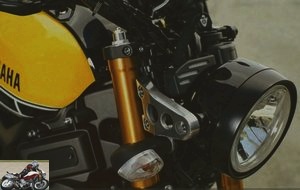
Powerful and elegant, the novelty knows how to successfully transcribe the aesthetic heritage of the brand. The angles disappear in favor of more sensual curves and the whole incorporates many elements in polished aluminum. Much more than anecdotal, these bear the style of the Yamaha. Headlight, speedometer and mudguard brackets, seat plates and radiator guards contrast with the darker overall livery. Particular care is taken to every detail to reinforce the vintage spirit.
Imposing, the round optic surrounded by a black ring is overhung by a mesh beam cover and the solid support of the instrument cluster. Hiding the 14-liter composite container, the tank is made up of three aluminum plates, fixed between them with aesthetic and large screws. These volumes, long and wide, can therefore be easily personalized. The upper plate offsets the filling orifice, for a more dynamic composition.
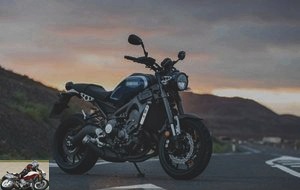
Completely new, the one-piece saddle rounds out its shapes and is adorned with a covering imitating alcantara stitched with discreet stitching. Uncluttered, the stern ends with a large round LED light overcoming a short mudguard. Purists will also easily eliminate the regulatory bib. More successful, the indicators are however not diodes. Tapered and screwed to the rear frame, the accompanying footrest plates go almost unnoticed.
This beautiful stylish set is based on an entirely aluminum structure, unchanged mechanics and technology to the latest standard. The discreet rear buckle tubes are bolted to a sturdy diamond-like frame. This set stretches its volumes in solid arms with flexible and profiled shapes, supporting the famous Yamaha block. The 847cc inline three-cylinder (CP3) with crossplane timing, dual overhead camshaft and four valves per cylinder, has a bore-to-stroke ratio of 78.0 x 59.1 mm. Particularly lively and Euro4 approved, it develops 115 hp at 10,000 rpm and torque of 8.30 da.Nm at 8,500 rpm. To cash in on its sporty temperament, the clutch is limited slip. In order to offer a desired machine (a little) less angry, Yamaha announces small changes.
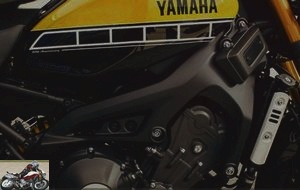
Thus, concerning the engine electronics, the three modes, A, Standard or B (the less lively), would all benefit from a smoother response. The anti-dribble system sees its efficiency enhanced by the use of softer clutch springs, reducing forces by 20%. The XSR 900 also incorporates a TCS anti-slip, adjustable on 3 intervention levels, permissive, more intrusive or inactive.
The blast of the three cylinders spins through manifolds plunging under the engine, thus masking the catalyst. Surrounded by metal, an ultra-short exhaust follows it, thus revealing the sporty banana arm. Mounted horizontally on rods, a damper adjustable in preload and rebound manages its oscillations over 130 mm. The front axle is supported by an inverted fork with 41mm and 137mm of travel, adjustable in rebound..
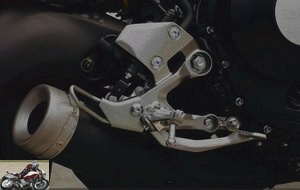
These suspensions have seen their characteristics modified with greater preload and braked hydraulics than that of the MT09. A very welcome development.
To curb the mechanical ardor, radial-mounted four-piston calipers attack the 298mm discs. The single piston opposed retarder bites a 245mm element. All under the supervision of a standard ABS system. Enough to stop without difficulty the rotation of the aluminum rims with five split branches. Bridgestone S20s fit them, sizes 120/70 and 180/55.
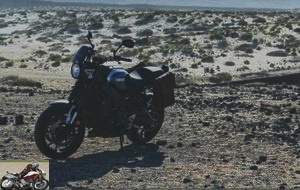
The whole makes up an attractive machine, with an assertive character reinforced by numerous aesthetic details. The finish is to match, with the frame and engine casings featuring carefully painted dark surfaces. Likewise, the footrest plates, boot guards and, on the right side, the protection of the pot, contribute to the excellent impression of quality emanating from the XSR 900. We also note a good integration of the hoses and other conduits or sheaths, despite a prominent and ungainly radiator. The only sticking point, the boxes bolted to the frame, containing the electronic devices. Finally, on the two standard versions, the fork sports a black tint, while the 60th anniversary version is adorned with golden sheaths. And despite a heavy metal cladding, the XSR 900 weighs only 195 kg (+ 4 kg than MT09).
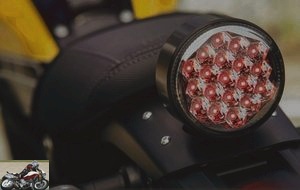
In the saddle
The major evolution of the MT09 working base is based on the saddle height and the length of the tank. With an altitude of 830 mm and an additional 50 mm container, the pilot dominates the machine more and above all comes in light support on the wide Renthal handlebars. What further optimize the ease on the handlebars and the agility, already unparalleled, of the cycle part. But let’s not anticipate. Less narrow, the seat does not hamper accessibility and the legs, barely spread by the reservoir, find a natural flexion.
Before the eyes, asceticism also reigns. Above the cast and forged aluminum handlebar mounts and bridges, the unique fully digital instrument block and negative display, concentrates a lot of information. Tachometer, speedometer, fuel gauge, two-part odometer, instantaneous and average consumption, engine and exterior temperature, Clock, engine mode chosen and TCS level retained. Attractive, complete and reasonably readable, it could however opt for a more generous size, allowing a more intuitive reading of certain indications. Likewise, it is necessary to scroll through the indications by pressing buttons surrounding the screen. More practical, TCS and D-mode adjust respectively to the left and right stalk, without delay of implementation.
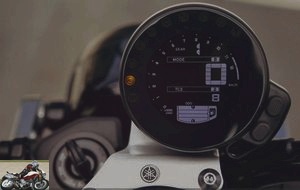
Well arranged, the controls are clear, the horn is also deported to the inside of the handlebars, limiting possible errors with the turn signals. Finally, the brake lever is adjustable in spacing but the current sheaths on the handlebars are a little too visible.
In the city
The ramage is more discreet than the plumage. We would have appreciated a more manly, more authentic rumble coming from the three cylinders. From the first meters, the roadster makes you forget the vintage to speak only about efficiency. Intuitive, the Yamaha XSR 900 takes itself naturally in urban evolutions. Balanced, lively, responsive to downforce, only its wide handlebars could slow down its course. With small dimensions, 1440 mm wheelbase and 103 mm caster, the machine is easy to maneuver and its very correct turning radius makes it a flawless city car. Finally, the mirrors return a clear image with a wide field.
Particularly flexible, the tuning forks block resumes at less than 50 km / h on the last report, smoothly. Likewise, the injection delivers go-arounds now smoother, especially in B mode. Precise, the gearbox locks with each pressure and the clutch is remarkably smooth. But all this does not mask a compulsive tendency to sport, the roadster just waiting for an opportunity to rush into the stretchers and break the concrete shackles of urban areas. Tired of curbing his desires on the boulevards, it’s time to let go.
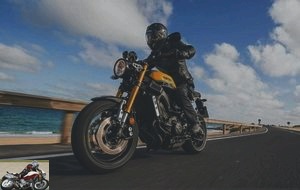
Motorway and expressways
The right grip should be screwed with care on the intermediates, at least if you want to keep the steering gear on the ground. Otherwise, you will save the front tire as the mill is in a happy mood. It is above all the absence of inertia in the revs that characterizes the Japanese three-cylinder. We quickly reach over 200 km / h, transformed into a flag clinging to the handlebars, seeking a utopian shelter behind the speedometer. Not very comfortable, the exercise emphasizes a very correct course holding.
After this peak, the regulation speed seems much more comfortable, stabilizing the mechanics at 5,200 laps. At this speed, the XSR 900 relaunches easily but without excess. Ample, acceleration does not suffer any respite but the last report is quite long. For more invigorating overtaking, we will go down a gear. And to better appreciate the vigor of the block, the sinuosities of the secondary network are required.
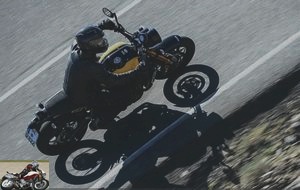
Departmental
Riveted to the abrasive bitumen of the island’s roads, the XSR 900 quickly shows a much better suspension tuning than that of its sister MT09 version 2015. Under the pressure of the three cylinders and the defects of the coating, the machine does not move any more. during muscular raises on the angle. Now healthy and a little less flexible, the machine asserts its dynamic potential more calmly. However, it remains comfortable, the equipment correctly absorbing the defects of the asphalt..
Furious, the Yamaha block makes its airbox rumble during the resumes, the vocalizations of the block then shifting towards more metallic trills. Despite its outfit playing the nostalgia of the charming crooner, the XSR 900 is more in the edgy rock and efficiency. Always available, the boiler works wonders beyond 6,000 revolutions / minute. At the approach of its maximum torque curve, the mechanics become explosive, then making use of its 115 big bourins until the breaker.
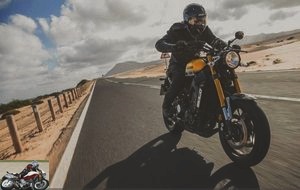
Much less capricious, the injection controlled by Ride by Wire makes it possible to control the machine serenely, whatever the D-mode selected. In use, the Standard profile is ideal, the sportier A hardly changing the reactions and still retaining a slight hiccup. Softer, mode B will be useful on slippery roads.
The new position induced by the raised seat works wonders, giving a much better feeling of the front axle. Precise and lively, it instinctively places itself on the desired trajectory. Neutral, it is easy to correct a heading error, the roadster being sensitive to the pressure on the footrests. With a large leverage, the machine swings from one curve to another with ease, its caster angle of 25º participating in its remarkable agility.
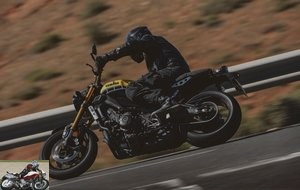
Likewise, it enters with naturalness on the brakes in bends and the grip of the levers hardly freezes the direction there. Fairly direct, the attack on the brakes requires a little restraint, but the decelerations are powerful and measurable. On very marked braking, the ABS returns late but effectively and discreetly in action, allowing sporty driving.
On the corner, the XSR 900 shows the same transparency and stability. We do not hesitate then, at the exit, to twist the right rubber, under the supervision of the TCS. No worries on the tire side where the Bridgestone S20s do not flinch under the kicks, contributing by their fairly round profile to the behavior and progressive reactions of the cycle part.
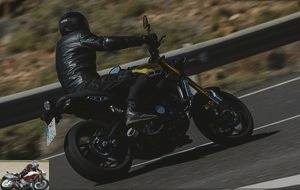
Part-cycle
Unsurprisingly, the XSR 900 benefits from a formidably efficient chassis with remarkable neutrality. And this, especially as its suspensions now give it a healthy behavior on all occasions. The biggest compressions are always a little harshly retransmitted by the shock absorber but these services remain fairly consistent with the standards of the segment..
For the most demanding, an Andreani fork kit is available for 561.60 € (including two 20-millimeter piston cartridges to adjust the compression, rebound and preload on very beautiful anodized caps). An Ohlins YA335 shock absorber, € 590, should sublimate the roadster.
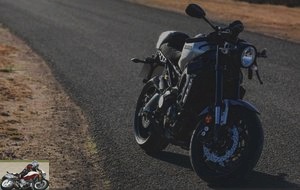
Braking
Powerful, almost too much on reflex braking, the front calipers provide sporty decelerations. A little dexterity will ensure an operation without anguish and without reproach. If the rear clamp quickly triggers the ABS, it complements the opposing retarders well..
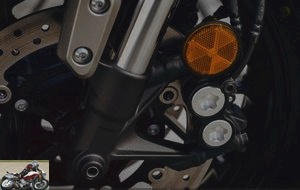
Comfort / Duo
More braked, the suspensions do not lose comfort, especially as the thick saddle contributes to the enjoyment of the pilot. Less careful, the passenger will have to deal with a reduced seat, high footrests and positioned forward, the absence of a grab handle and smart mechanics. A personal choice that blind love alone could motivate.
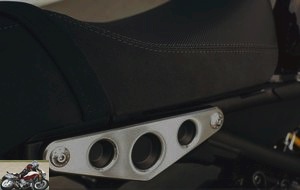
Finally, flexible saddlebags can decorate the machine for longer trips..
Consumption
After 162 km borrowed at brisk pace and composed of many starts / accelerations, my reserve indicator then manifested itself, that is to say a consumption of nearly 7 liters per 100. Some of my colleagues, on the other hand, made less than 6 liters . During the second part of the journey, more reasonable and consistent with usual use, the XSR 900 only swallowed 6.3 liters of unleaded, allowing 220 km. A decent number to water a dynamic cavalry thirsty for sport. Yamaha provides a maximum range of 270 km…. probably under Tranxene.
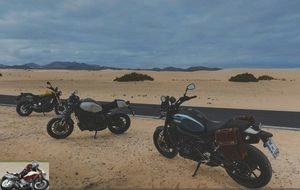
Conclusion
On a proven and dynamic basis, Yamaha offers a distinctive and charming roadster with timeless lines. The evolutions made to its electronics and its suspensions optimize this vintage version of the MT09 model. Seductive, the XSR 900 is appreciated whatever the type of piloting. With the usual paces, its obviousness makes it a docile companion, with mechanical gentleness and a charming couple. At a more sporty pace, we appreciate the ease and ease of a homogeneous and straightforward machine. And at all times, we benefit from a machine of character with a flawless finish. Priced at € 9,699.00 and € 9,999.00 in the 60th Anniversary version, the XSR 900 plays a style-performance card with no real competition. More expensive by € 1,200 than the MT09, its quality finishes and its potential for customization will appeal to fans of typical machines..
We will oppose him the Ducati Monster 821 Red, at 10,995 €. Efficient and, a little, customizable, the Bolognese does not lack assets but does not offer the same style difference. Another captivating Italian, the Moto Guzzi 1200 Griso 8V SE asking for € 12,490.
More consistent and efficient than its rivals, the Yamaha XSR 900 should have a successful career and easily build its own heritage..
Strong points
- Assertive style
- Powerful mechanics
- Quality finishes
- Improved suspensions
- Braking
- Rigid cycle part
Weak points
- Reduced color choice
- Counter display too small
The technical sheet of the Yamaha XSR 900
Related articles
-
Thin blade Single cylinder with variable valve timing, 124.7 cm3, 15 hp and 12.4 Nm, 142 kg, 5,299 euros For several years, small sports cars have made a…
-
driving school 4 cylinders of 999 cm3, 95 hp, 92 Nm, 214 kg full made, 19 liter tank Of its maxi sport roadster GSX-S 1000, Suzuki offers a 950 version…
-
Yamaha Tracer 9 and Tracer 9 GT motorcycle test
Cross-country sprinters 3 cylinders in line, 889 cm3, 119 hp and 93 Nm, 213 kg full made, from 11,499 euros Road trail, sport-touring, road … the names…
-
Triumph Trident 660 motorcycle test
Harpoon the competition 3 cylinders in line, 660 cm3, 81 hp and 64 Nm, 189 kg full made, 7,995 euros In the early 1960s, the Speed Twin was the British…
-
Evil Torgnole power 10 New sporty troublemaker in the successful Yamaha range, the MT10 sets new standards in terms of four-cylinder mechanics. Its…
-
Trace strong and far The impressive commercial success of the Yamaha MTs is a quantified reality: 3,700 MT-09 (including 15% of Street Rallye and Sport…
-
Hot in front… Swedish until 2007 and now owned by BMW, Husqvarna has seen all of its business (development, production, marketing) move to Varese,…
-
Comparison test Triumph Tiger 900 GT Pro and Rally Pro
Annexation of new territories 3 cylinders in line, 888 cm3, 95.2 hp, 87 Nm, 198 kg and 201 kg, euros Although the creative nation of rugby, the English…
-
Authentic sensations Ducati knows how to offer models that transcend its history, such as its Monster, in its range. The success of the latter is based…
-
Light up your dark side The Monster saga has been written since 1993 with its large displacement models M900, M1000 ie, S4R, M1100. But the younger girls…
On the Suzuki site it is displayed at 6199 euros .. as much as an MT07
How many cases of shock absorbers and forks of gex Suzuki does it have in stock? ???
There was a way for a few € more to make a weapon and create a challenge.
What a waste …
Ah, you must have put a 5 for a 6.
Yes too bad, 600 balls more led fire and repro, it’s expensive; and especially brakes a bit better to match a good fork … well, in short.
PS: tain, David, you took 220, it’s going to snow…
Very good test report, objective and complete…
I fulminate against Moto Revue which, in its issue currently on newsstands, treats this beautiful SV 650 S as a cheesy motorcycle, outdated (still happening) but above all which finds that it is dragging itself: we are still talking about 200 km / h…
Hence – compared to your test, David – I remain skeptical about the “motorcycle for beginners” side: as much its ease of handling justifies this qualification, as the 74 CV and the 200 km / h seem to me a little high for a real beginner.
Heavier than average ?
The ER6f passes 200kg, and the 4 cylinders much more!
Only the Yamaha 700 is lighter, but has no fairing